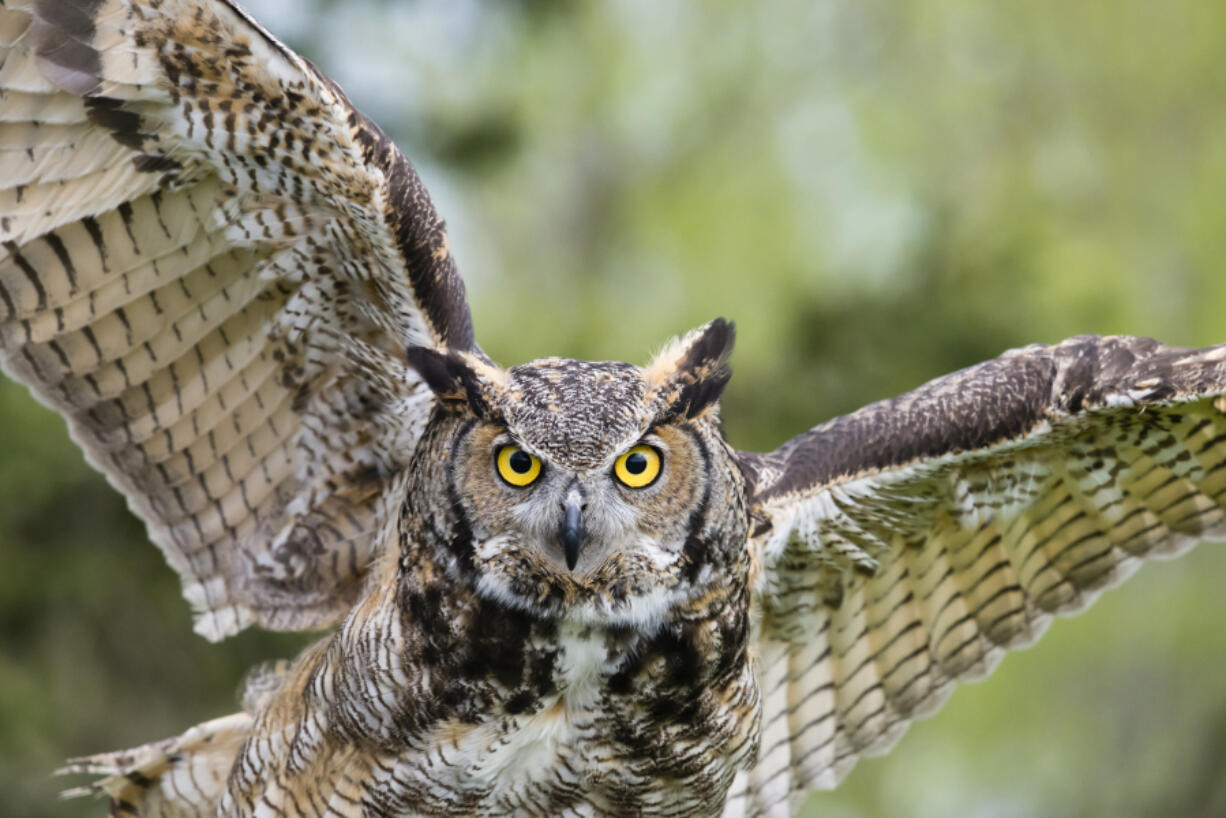If you’re an early morning jogger or walker, here’s an unexpected reason to steer away from tall, mature trees when you head out between late fall and early spring: aggressively territorial owls.
Just ask Cheryl Miller, the teacher-librarian at Jason Lee Middle School, who lives on the west side of Vancouver. One day in late January, Miller said, she went out for her pre-work run at 5:30 a.m., when it was still dark outside.
“I’ve been doing this in the morning for over 20 years,” she said.
Because she runs down darkened streets, Miller doesn’t skimp on making herself safely visible to traffic.
“I wear safety equipment, bright reflective clothing and a blinking light on my stocking cap,” she said.
Miller was jogging at the corner of 36th and Daniels streets, she said, when something clocked her atop her hatted, lit-up head.
“It was quite hard. It was extremely startling,” she said. “I was thinking, ‘It’s dark, maybe I hit a tree branch.’ ”
She stopped and looked around. She saw nothing. She started running again.
“Then I see swooping right in front of me this very large, dark shadow,” she said. “It swooped across the road, right in front of me. I thought maybe it was a bat, but it wasn’t flying like a bat.”
Miller watched the dark shape settle on a tree branch near a streetlight, where she could see that it was an owl.
“It perched in the tree just looking at me with those big-huge owl eyes,” Miller said. Later, Miller said, she compared her sighting to images in a birding ID app and concluded that she’d been strafed by a great horned owl.
“It was the right size and silhouette, and those ears,” she said.
The owl kept staring at Miller from its perch. Miller tried to shoo it away, but it wasn’t impressed. So she kept running.
That’s when she felt another sudden slam in the head, she said. And then her hat was gone.
“Flying away from me is my flashing light,” she said. “The owl flew off with the hat and perched on an overhead wire. It was holding my hat. It was really disconcerting. I wanted my hat back!”
The owl didn’t move. Miller eventually continued her jog, then circled back, hoping the owl had dropped the hat. But owl and hat were both gone. (If you spy an owl wearing a blinking-light hat somewhere on the west side of Vancouver, now you know where that hat came from.)
“I never saw the hat again,” Miller said.
When she told students at Jason Lee about her experience, one replied that Miller must be meant to work alongside owls, like in Harry Potter’s world.
“You should be a librarian at Hogwarts,” the student told her.
Swooping season
Hogwarts is where owls are magical — and friendly. But Miller’s experience brings to mind a scarier cinematic vision: the fatally unfriendly avian flocks in Alfred Hitchcock’s “The Birds.”
Don’t go there, said Stephanie Herman, the assistant director of conservation at the Bird Alliance of Oregon (formerly Portland Audubon).
“We are definitely not in a Hitchcock film,” Herman said. “When animals behave like this it is because the animal is perceiving a threat. They’re not malicious or violent, they’re trying to protect themselves and their families.”
Herman said that owl “swoopings” are seasonal, usually occurring between late fall and early spring — breeding and nesting season. But Ken Bevis, a stewardship wildlife biologist with the Washington Department of Natural Resources, said he’s seen it happen in late summer and early fall, too.
“I suspect this person inadvertently went close to the owl nest, or at least the male that was sitting on patrol nearby the nest,” Bevis said, and the owl “chose to swoop to scare this running creature away.”
While Miller identified her assailant as a great horned owl, barred owls — which are larger and more aggressive — are usually the culprits in “swooping incidents,” Bevis said. (Members of Vancouver Audubon added that they’ve experienced or heard about similar swoops by hawks and other species but those are even rarer.)
Owl swoopings sure can be startling, Herman said, but they rarely cause anything more serious than bumps and scratches.
“They’ll generally only get close or knock hats off heads,” she said. “Beanies, and beanies with pompoms in particular, seem to be the victims of owl swooping more often than not.”
If you’ve been swooped by an owl, Herman said, consider changing your headgear to something without a light or pompom — or, even better, just change your route for a while.
“Give them space and avoid that specific part of the area or trail so the owl can feel safe and raise its young undisturbed. It’s a temporary situation, and usually it is possible to just take a detour,” she said.
Let park officials know about owl swoopings and they may be able to put up a warning or detour sign, she added. If you absolutely must traverse that very spot, consider bringing an umbrella for the owl to target, instead of your head.
Or, Bevis added, just try running a little later, after owls (which tend to be nocturnal or crepuscular, active at night or in twilight) have gone to sleep. Better still, he said: Don’t even worry about owl attacks, which are really quite unusual.
“Might worry about lightning more,” he said. “Or black widow spiders. The most dangerous critter out there is two-legged, and I don’t mean Sasquatch.”
“Keep in mind that animals do not have a sense of recreational or private property,” Herman said. “Having lots of natural areas brings tons of benefits for us humans to enjoy, and also comes with some responsibility for us all to make space and be respectful of the wildlife that shares these spaces.”




